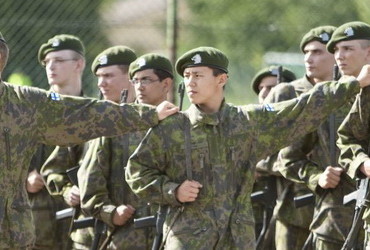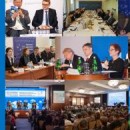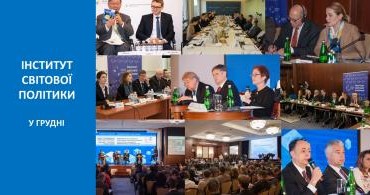An article written by Charly Salonius-Pasternak, Senior Research Fellow at the Finnish Institute of International Affairs for IWP’s study “Ukraine-NATO: Diagnosing the Partnership”The full publication “Ukraine-NATO: Diagnosing the Partnership” is available here.
There are several hypotheses in public discourse regarding the possible security format for Ukraine if its full membership in NATO is not a realistic prospect. Among those versions, we should mention frequent claims on reasonability of the Finnish model, which means membership in the EU without a full integration into NATO. Meanwhile, after Russia’s aggression, the perception of Euro-Atlantic integration has changed in Finland, and debates on the country’s possible membership in the Alliance have been revived.
The finnish model. What is that?
Finland’s foreign and security policies are marked by official continuity interrupted by significant changes, yet, behind the scenes, relationships with actors that are important to Finland are continuously changing. The end of the cold war and the abrogation of the Agreement of Friendship, Cooperation and Mutual Assistance with the Soviet Union, and entry into the European Union are two such significant changes. Through this time, Finland has maintained a broad view of security and continues to focus on national defense, relying on a military based on conscription and a large reserve. Annually more than twenty-thousand men and between three and four hundred volunteer women are trained by the Finnish Defense Forces (FDF), which during peacetime consists of more than eight thousand soldiers (8000) and five thousand (5000) civilians. The fully mobilized wartime force is around two hundred and thirty thousand (230,000+) soldiers. The annual defense budget of around 2 700 million Euros (1.28% of GDP) used to have a better balance between procurement, operations and salaries but for 2014 about 17 % went to procurement, 68 % for general operational costs and the remainder for salaries. Only around 1.5% of the defense budget is used for international peacekeeping or crisis management operations. As a whole, it is clear that Finland continues to focus on national territorial defense, while contributing around five hundred soldiers to diverse international operations. Experiences from international operations make it clear that in terms of professionalism and capability, Finnish reservists perform well compared to all-volunteer forces, and interoperability between Finnish army, navy and air-force units and NATO-member forces is exceptionally high.
Clearly Finland’s relationship with NATO has evolved significantly since 1994, when it first joined the Partnership for Peace (PfP) program. These two decades long period of increased and deepened cooperation has been enabled the step-by-step building of trust on both sides. Fundamentally this has had to do with Finland repeatedly showing that it can be relied on to deliver what it has promised, whether in crisis management operations, exercises or other forms of cooperation, and NATO for its part including Finland in many types of activities that had previously been reserved only for members.
The most visible part of the relationship has been Finland’s participation in various NATO-led crisis management operations. Starting in 1995, Finland contributed a battalion to the IFOR and subsequent SFOR (starting in 1996) crisis management operations in the Balkans. When the KFOR operation in Kosovo was launched in 1999, Finland contributed a large battalion consisting mainly of reservists. Of particular note is that Finland was the first non-NATO country to be given operational command of a NATO brigade (Multinational Brigade – Center). Finland joined the ISAF operation in Afghanistan January 2002 contributing anywhere from fifty to over two-hundred soldiers at any given time, while contributions to the follow-on mission Resolute Support is around eighty soldiers.
Finland has also actively participated in the work of the various security related groupings and committees gathered under the auspices of NATO. In 1997 Finland became a member of the Euro-Atlantic Partnership Council (EAPC), started actively participating in the Civil Emergency Planning (CEP) work, including earmarking fourteen experts for its eight sub-committees. In 1998 Finland began contributing to the Euro-Atlantic Disaster Response Coordination Centre (EADRCC), a Russian initiative.
Starting during the 1990s but systematically increasing during the past decade, Finland has participated in defense materiel cooperation, sought to increase interoperability by adopting NATO standards and has used the Planning and Review Process (PARP) and its Partnership Goals (PG) to develop its own national defense. For example Finland participates in the Strategic Airlift Capability project, and has participated in NATO Response Force (NRF) since 2008, partially to gain more access to NATO standards and procedures, and has since the 1990s ensured that all procured materiel fulfils NATO standards. In September 2014, Finland and Sweden signed a Memorandum of Understanding with NATO on Host Nation Support, and became a part of the Enhanced Opportunities Partnership program (EOP) enabling further cooperation.
It is noteworthy that this substantial increase in both breadth and depth of cooperation has been supported by Finnish politicians from a wide range of political backgrounds; it is not the project of just a few parties. This has enabled long-range and stable planning by the various governmental agencies and ministries involved in cooperation with NATO.
Politically ever deeper cooperation with NATO has also required Finland to adopt different concepts regarding its position in the realm of security politics. European Union membership in 1995 is seen as a fundamental foreign, security and economic choice by Finland, and with EU membership the language of neutrality faded from official usage. It has been replaced at first by statements about Finland ‘not being militarily allied’ to more recently (post EU Lisbon treaty) Finland ‘not being a member of a military alliance’.
How does the finnish society perceive integration into NATO?
Opinions on whether or not Finland should seek to become a member of NATO divide both Finnish popular opinion and politicians. The specific polls vary, but in general during the past decade 60 to 70% of the population has opposed Finnish NATO membership, while between 20 and 30% of the population supports it, with around 10% not having an opinion. This contrasts with polls conducted of officers in Finland, where around half of all officers support membership, and around 70% of colonels and above ranks support membership.
The main reasons the general population at large gives for being against Finnish NATO membership have to do with Russia and its proximity, and that NATO is not seen to increase Finnish security. Those who favour NATO membership give as their main reasons that membership would generally increase Finnish security and specifically address threats emanating from Russia. This is one of the aspects which make the situation difficult for politicians; both sides of the argument use the same reasons to argue for their position.
Of the political parties represented in the Finnish parliament, only the conservative National Coalition and Swedish People’s Party (liberal) openly favour Finnish NATO membership. The Finns, Social Democratic, Center and Green parties all remain open to Finnish NATO membership but do not think it is necessary at the moment. The Left Alliance is ideologically opposed to Finnish NATO membership.
Overall, opinions regarding Finnish membership in NATO are relatively stable, though the recent negative changes and general instability in the regional security situation has moderately increased support for Finnish membership. However, this increase in support for cooperation applies to all types of military cooperation, with bilateral Swedish (94%), Nordic (94%) and EU (86%) cooperation receiving support from the great majority of the population; support for cooperation with NATO is notably less at 56% of the population. In parallel with increased support for Finnish NATO membership, polls show that more Finns think defense policy has been handled badly or very badly, with a quarter of the population now feeling this way compared to less than 20% in 2011.
Looking at a diverse range of polls and questions, the view among the population seems to be that while there are concerns regarding Finnish defense and security policy, the general approach is approved by a significant majority of the population. In practice this means there is no real political pressure to radically alter the pillars of Finland’s defense: focus on national territorial defense, conscription and a large reserve based military, and continuing military cooperation with other countries but not belonging to a military alliance.
Despite this seeming stability, Finnish NATO membership is a constant part of security and defense policy discussions in Finland. To understand the debate, it is necessary to be aware of a few things which influence it. First, the discussion is dominated by a labeling of people as either NATO hawks or Finlandized cold warriors. This means that debates are frequently based on myths, false information or specific views regarding national identity and what enabled Finland’s success during the cold war.
Finnish fears and myths
Perhaps the strongest myth, that the Finnish people can never rely on assistance from other countries relates to national identity and an incomplete understanding of history. During independence (since 1917) Finland has in fact been given assistance when an assistance/defense pact existed. Without German assistance Russia would likely have succeeded in its attempt to break Finnish defenses and occupy Finland in the fall of 1944. This view about the unreliability of outside assistance is in the case of NATO compounded by two remnants from the cold war: (1) that the Warsaw Treaty Organization (WTO) and NATO were given equal billing as dangerous military alliances and tools that their largest members used for their own benefit; and, (2) that Finland’s policy of neutrality kept it out of superpower confrontations during the cold war, and that NATO membership would draw it into such confrontations. Finland’s EU membership has through the enactment of multiple rounds of economic and political sanctions made it obvious that it already cannot hope to stay outside of power politics. Moreover, on a purely military level, it is unclear how Finland as a EU member and close partner with NATO could, for example, imagine staying out of a conflict or crisis in the Baltic Sea region.
Information, and its purported lack regarding the impacts of Finnish membership in NATO is often used as a reason why real debate is not possible and political decisions are not made. This is completely untrue. There are multiple official and academic studies on the military, political, and legal impacts of membership. In addition to this, there are dozens of papers and various high quality books published on the subject. Despite this, debate is frequently hobbled by patently false charges, such as Finnish NATO membership resulting in NATO nuclear weapons being placed in Finland (NATO has no nuclear weapons, some of its members do, and Nordic members of NATO have a peacetime opt-out on this), that as a member Finland would then be required to participate in American imperial wars or be required to give up its reservist based national defense system. Compounding these specific understandings of national history and incorrect information is a somewhat aged understanding of what modern warfare is like, and what it demands in terms of capabilities. This has an impact on the expectations about what kind of assistance Finland could expect if it was a NATO member.
The above suggests that while the new government led by Prime Minister Sipilä (Center Party) has returned to the position that Finland retains the option to seek NATO membership during the four year mandate period, it is unlikely that Finland will join – absent a Swedish decision to seek membership. Sweden’s decision to join is frequently cited as one of two situations when Finland would seek membership. The other is if the political elite (president, government and all large parties) jointly decided to seek membership, thereby turning public opinion in favour of membership. Polling suggests such a turn in public opinion is possible, but there is little evidence that the political elite would come to such as consensus decision.
In the case that Finland and Sweden would decide to seek NATO membership, it would of course be up to the existing member states to decide if they accepted a particular state as a new member. Official and unofficial statements indicate that in the case of Finland and Sweden the membership negotiations process would be quick and accession would be successful. On the military technical level Finland’s level of interoperability is higher than for a number of existing members but, membership would require changes in Finnish law, including the constitution. It is likely that some NATO member states would communicate their concerns with taking two new members, especially since Finnish accession would approximately double the land border between Russia and NATO members but it is difficult to see how two stable democratic EU members with modern and NATO interoperable forces would be rejected as members.
Overall, while NATO membership is frequently a part of Finland’s security policy debates, it only forms a part of the overall Finnish understanding of security. Even the strongest supporters of Finnish NATO membership only see membership as one component of national security. Finnish security is certainly enhanced and improved by the close cooperation with NATO but its foundation is built on a broad or comprehensive societal security concept. Within this concept successive governments have identified seven vital functions of society, one of which is Finland’s defense capability. This broad concept of security is built on a societal ‘deep security’, which is based on universal literacy, economic equality, freedom of press, multi-party democracy and trusted rule of law, all of which provides a generally inhospitable environment for anyone seeking to use hybrid or non-linear warfare against Finland.
The above described relationship between NATO and Finland (and to a large extend Sweden) is quite unique, and would be difficult to replicate. Yet, few lessons or observations relevant to Ukraine can be extracted from it. A deep relationship with NATO can be very beneficial for supporting the long-term development of a robust national defense force, and even as a NATO member this national defense force must be kept strong. The relationship can best be built through continuous practical and pragmatic cooperation, showing both individual member states and NATO as an institution that one is willing to contribute to broader (cooperative, in NATO’s terminology) security while seeking to strengthen one’s own capabilities. This trust developing process takes time and is facilitated by strong bilateral relationships, with a NATO member country often being able to work as a ‘sponsor’ or introducing issues and areas of cooperation that are mutual beneficial to a partner country and NATO. In Finland’s case, it also made a habit of sending its best soldiers and civilians to postings, and being better prepared in many instances than some members, underlining the weight Finland put in the development of the relationship.
Finland’s relationship with NATO, where in the eyes of many observers Finland takes the risks of NATO membership without receiving collective defense guarantees, is partially dependent on membership in the European Union, like Sweden, and in Finland’s case also the Eurozone. These two provide both political and economic motives for other states (including many NATO members) to support deeper cooperation and potentially consider bilateral assistance during a crisis. On the other hand, the other partners in NATO’s most exclusive cooperative program, the EOP are not EU members (Jordan, Australia and Georgia).
At the rhetorical level Finland’s relationship with Russia is frequently cited as being better and stronger because Finland is not a NATO member, but pre-Ukrainian war NATO member Norway had good relations with Russia, even cooperating militarily in Arctic search and rescue capabilities; this is in contrast to Finland which has no military to military cooperation with Russia. This suggests that there is nothing inherent in NATO membership that prevents reasonable relations between a member and Russia, though Russian ideas about identity and history clearly impact which countries it deems can acceptably become NATO members. In Finland’s case Russia has made it clear that it thinks Finland should not join NATO, and that such a move would result in serious repercussions and actions by Russia. Most extremely, Kremlin’s ‘messenger’ Sergei Markov stated in an interview in Hufvudstadbladet in on June 8th, 2014 that if Finland wants to become a NATO member, it would decrease European security and ultimately that Finland should consider whether it wants to be the reason for the beginning of World War III. Ukraine has experienced far worse than threats for wanting to link its future with the European Union and NATO, but it suggests that membership in NATO is seen by Russia as far more dangerous than membership in the European Union.
The study was conducted within the project Strategic Discussion Club in the Regions, implemented by the Institute of World Policy in partnership with the NATO Liaison Office in Ukraine and with the support of the Government of Norway.
Opinions expressed in this publication do not reflect the official positions of NATO and the Government of Norway.




Comments theme
Comments themeComments themeComments themeComments themeComments themeComments themeComments themeComments themeComments themeComments themeComments themeComments themeComments themeComments themeComments themeComments themeComments themeComments themeComments themeComments.